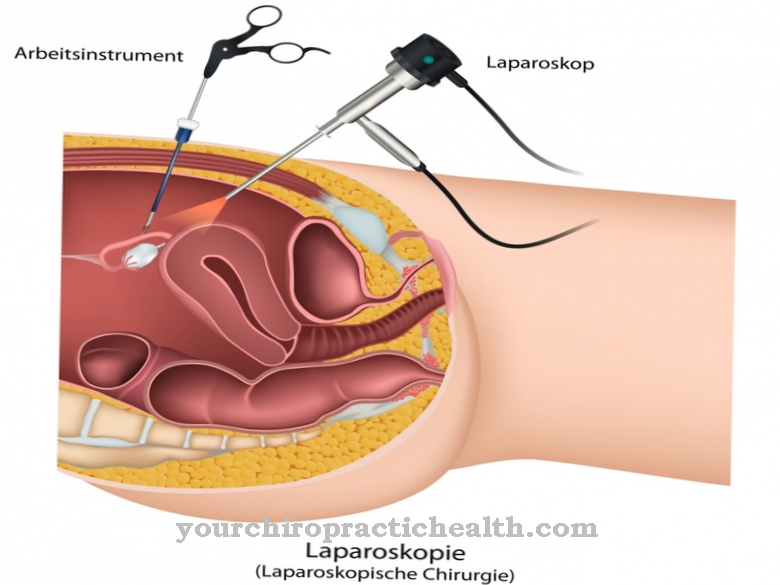As Electrocochleography (ECochG) is a method used in audiometry or ear, nose and throat medicine to record electrical potentials that the sensory cells (hair cells) in the cochlea generate in response to acoustic clicks or short tones at different pitches can be.
Three different electrical potentials are recorded, which allow detailed conclusions to be drawn about the function of the inner ear in the presence of a sensorineural disorder.
What is electrocochleography?

Electrocochleography (ECochG) is a method that enables the measurement and recording of electropotentials generated by the hair cells in the cochlea in the inner ear in response to acoustic stimuli, and to compare them with the input signals. The main function of the hair cells in the cochlea is to convert mechanical sound waves into electrical nerve impulses, analogous to frequency and volume. In the ECochG, three different electropotentials are measured and recorded as an electrocochleogram.
These are the microphone potential that corresponds to the input signals, the summation potential that was generated by the hair cells in response to the acoustic stimuli and the nerve action potential that is transmitted to the corresponding afferent fiber of the auditory nerve (vestibulocochlear nerve). In order to be able to record the three different action potentials well, an electrode must be placed as close as possible to the cochlea. A non-invasive and an invasive method are available for this.
In the non-invasive method, the electrode is placed in the external ear canal near the eardrum. In the much better, but invasive, method, a fine needle electrode is brought through the eardrum to the cochlea.
Function, effect & goals
In the case of recognizable hearing impairments, it is important to know whether it is a sound conduction problem or a sound sensation problem in order to select a targeted therapy or technical support. In the case of sound conduction problems, there is a malfunction in one of the mechanical components of the hearing aid in the outer or middle ear. Sound perception problems arise when one of the "electrical" components in the inner ear or the auditory nerve (vestibulocochlear nerve) or the processing centers in the brain are functionally impaired.
A number of tests and procedures exist to identify a hearing problem as a conductive or sensory sound disorder. If a sound sensation problem is detected, further diagnostic procedures are used to narrow down the causative factors. The only available diagnostic tool for a detailed functional examination of the inner ear or the cochlea is electrocochleography, which enables a differentiated analysis of the individual components of the cochlea. The acoustic stimuli are generated by the diagnostic device in the form of an automated sequence of so-called clicks and short tones and transmitted to the external auditory canal with a tiny loudspeaker or tube.
The functioning sound conduction process of the hearing system ensures that the sound waves are transmitted to the cochlea via the eardrum and the ossicles. The process of translating sound waves into nerve action potentials through the inner and outer hair cells in the cochlea is recorded and recorded by the ECochG. The findings that the electrocochleogram allows are particularly important for the development and customization of a cochlear implant in the presence of a severe form of cochlear sensorineural hearing loss.
The ECochG also serves as one of the diagnostic procedures that are used when Menière's disease is suspected. Menière's disease is a seizure-like disease of the inner ear that, in addition to hearing and tinnitus, is particularly associated with a sense of balance and vertigo. The disease is ultimately caused by an overproduction of the perilymph that fills the inner ear. Sensorineural hearing loss or deafness is often based on a functional disorder or total failure of the inner or outer hair cells, which translate the sound stimuli into electrical nerve potentials in a complex process.
In these cases, provided that the auditory nerve and the processing centers in the brain are intact, a cochlear implant can restore part of the hearing ability even if the patient is completely deaf. This also applies to children born deaf and whose cochlea is inoperable. You can have a cochlear implant placed under the age of 2. Your brain is still particularly capable of learning, so experience has shown that the hearing centers in the CNS can adapt particularly well to the new "hearing situation".
The implant is inserted into the cochlea and is wirelessly connected to a recording device worn on the outside of the body, which processes incoming noises using complex algorithms and transmits them to the implant, which then stimulates the spiral ganglion. The system takes over the entire sound processing chain from the external auditory canal via the eardrum and the ossicles in the middle ear up to and including the translation of the sound stimuli into nerve impulses in the cochlea.
You can find your medication here
➔ Medicines for earache and inflammationRisks, side effects & dangers
If an electrode is used in electrocochleography that is placed in the external auditory canal, the procedure is non-invasive and no chemical substances or drugs are taken, so that the procedure involves (almost) no risks and is almost free of side effects. The only risk is that the sensitive skin of the external ear canal will react to the insertion of the electrode with inflammatory reactions, which in very rare cases can be painful and require further treatment.
The risk of complications is slightly increased if a needle electrode is used that is passed through the eardrum and placed in the inner ear. As a result, the ECochG is basically invasive. In very rare cases - as with any invasive procedure - infections and inflammations can be triggered by imported pathogenic germs, which require further treatment. In extremely rare cases, an inflammation can develop on the perforated eardrum, which after healing leads to the formation of scars that impair hearing.
Books on ear diseases













.jpg)

.jpg)
.jpg)











.jpg)